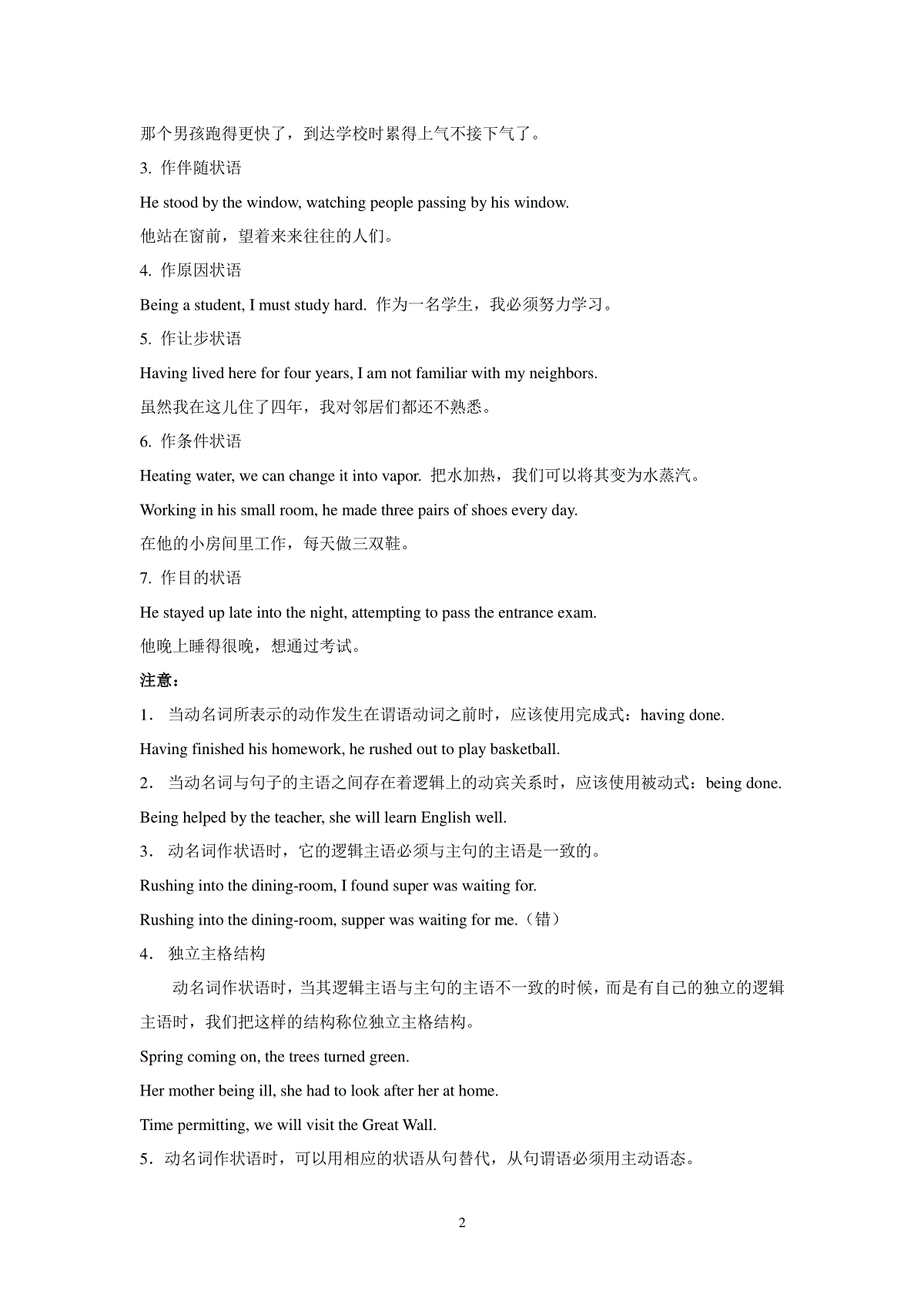当前位置:首页 > 中学教育 > 初中教育 > Book-4-Unit-4-Grammar-动名词作定语-状语
1Book4Unit4Grammar动名词作定语,状语一、动名词作定语动名词作定语时,在句子中通常有两个位置:如果是单个的动名词作定语,常放在被修饰的名词前面作前置定语;如果是动名词短语作定语,则放在被修饰名词的后面,作后置定语。1.动名词作定语,说明被修饰词的性质、特征或用途。Hemaybeinthereadingroom.他可能在阅览室里。Theysetupanoperatingtable.他们搭起一个手术台。2.动名词作定语,表示其与被修饰词之间为主动关系,并且表示动作正在进行。Thereareabout200studentsstudyinginthisschool.大约有200个学生在这个学校学习。WhoisthewomantalkingtoourEnglishteacher?正在和我们英语老师谈话的那个女人是谁?3.有些动名词已经转化成了形容词,常用作定语修饰物,表示“令人……”:exciting,shocking,puzzling,confusing,disappointing,discouraging,boring,tiring,moving,touching,interesting,satisfying,frightening,amazing等。Thatmustbeaterrifyingexperience.那肯定是一次可怕的经历。Theexperimentwasanamazingsuccess.那实验是一个惊人的成功。注意:如果动名词与被修饰词之间是被动关系,就要用它的被动式beingdone,通常表示正在被做,常作后置定语。Thetallbuildingbeingbuiltnowisournewschool.正在被修建的那建筑是我们的新学校。Thatquestionbeingdiscussedwaspresentedbytheheadmaster.正在被讨论的那个问题是校长提出来的。二、动名词作状语动名词或动名词短语可以在句子中作状语来修饰谓语动词或整个句子,表示动作发生的时间、原因、条件、结果、方式、让步或伴随状况。动名词作状语,其逻辑主语必须与主句的主语一致。动名词作状语时,可以单独使用,也可以在其前加上when,while,after,if,unless,although,though等连词。1.作时间状语Hearingthisnews,shegotfrightened.听到这个消息,她感到害怕。Whilereadingthebook,shenoddedfromtimetotime.当她看书的时候,不时地点头。2.作结果状语Theboyranevenfaster,reachingtheschooloutofbreath.2那个男孩跑得更快了,到达学校时累得上气不接下气了。3.作伴随状语Hestoodbythewindow,watchingpeoplepassingbyhiswindow.他站在窗前,望着来来往往的人们。4.作原因状语Beingastudent,Imuststudyhard.作为一名学生,我必须努力学习。5.作让步状语Havinglivedhereforfouryears,Iamnotfamiliarwithmyneighbors.虽然我在这儿住了四年,我对邻居们都还不熟悉。6.作条件状语Heatingwater,wecanchangeitintovapor.把水加热,我们可以将其变为水蒸汽。Workinginhissmallroom,hemadethreepairsofshoeseveryday.在他的小房间里工作,每天做三双鞋。7.作目的状语Hestayeduplateintothenight,attemptingtopasstheentranceexam.他晚上睡得很晚,想通过考试。注意:1.当动名词所表示的动作发生在谓语动词之前时,应该使用完成式:havingdone.Havingfinishedhishomework,herushedouttoplaybasketball.2.当动名词与句子的主语之间存在着逻辑上的动宾关系时,应该使用被动式:beingdone.Beinghelpedbytheteacher,shewilllearnEnglishwell.3.动名词作状语时,它的逻辑主语必须与主句的主语是一致的。Rushingintothedining-room,Ifoundsuperwaswaitingfor.Rushingintothedining-room,supperwaswaitingforme.(错)4.独立主格结构动名词作状语时,当其逻辑主语与主句的主语不一致的时候,而是有自己的独立的逻辑主语时,我们把这样的结构称位独立主格结构。Springcomingon,thetreesturnedgreen.Hermotherbeingill,shehadtolookafterherathome.Timepermitting,wewillvisittheGreatWall.5.动名词作状语时,可以用相应的状语从句替代,从句谓语必须用主动语态。3Whilereadingthebook,shenoddedfromtimetotime.=Whileshewasreadingthebook,shenoddedfromtimetotime.Beingastudent,Imuststudyhard.=AsIamastudent,Imuststudyhard.Notknowinghowtodoit,heaskedtheteacherforhelp.=Ashedidn’tknowhowtodoit,heaskedtheteacherforhelp.由于不知道如何干,他请老师帮助。6.固定结构Judgingfromhisappearance,hemustbeveryrich.Generallyspeaking,hisanswerisright.★非谓语解题“五步骤”:1、牢记核心意义。不定式表将来或能够,动词ing形式表主动或进行,过去分词表被动或完成。2、分析句子成分。判断句子中是欠缺谓语还是非谓语。(主要是看句子中已经有没有谓语动词了,因为英语中一个简单句中只能有一个谓语动词。)3、寻找逻辑主语,把握主被动关系。非谓语动词虽然在语法上没有主语,但它仍表示的是动作,因此在意义上会有一个动作的发出者,这个发出者就是它的逻辑主语。如果非谓语动词与其逻辑主语之间是主动关系,用现在分词或不定式的主动式;如果非谓语动词与其逻辑主语之间是被动关系,则用过去分词或不定式的被动式;如果表被动进行,则用现在分词的被动式或不定式的被动进行式。4、了解时间关系。如果非谓语动词与句子的谓语动词所表示的动作同时发生,用一般式;如果发生在之前,则用完成式;如果强调正在进行,则用进行时;如果动作在将来发生,则用不定式。5、分析特殊情况。主要是指一些习惯用法,固定搭配等。练习一:1.Thestrangersaidsomethingina_______voiceandthelittlegirlwasverymuch_______.A.frightening,frightenedB.frightened,frighteningC.frightening,frighteningD.frightened,frightened2.________thepiano,someonesuddenlyknockedatthedoor.A.PlayingB.WhenIwasplayingC.RepairingD.Examining43.Mothercaughttheboy______inthecorner.A.smokeB.tosmokeC.beingsmokedD.smoking4.______theprogram,theyhavetostaythereforanother2weeks.A.NotcompletingB.NotcompletedC.NothavingcompletedD.Havingnotcompleted5.“Wecan’tgooutinthisweather”,saidBob,____outofthewindow.A.lookingB.tolookC.lookedD.havinglooked6.Though_____money,hisparentsmanagedtosendhimtouniversity.A.lackedB.lackingofC.lackingD.lackedin7._______suchheavypollutionalready,itmaynowbetoolatetocleanuptheriver.A.HavingsufferedB.SufferingC.TosufferD.Suffered8.Helookedaroundandcaughtaman______hishandintothepocketofapassenger.A.putB.tobeputtingC.toputD.putting9.______intheseatofhalfanhour,Tomsuddenlyrealizedthathehadlefthiswalletathome.A.TowaitB.HavewaitedC.HavingwaitedD.Tohavewaited10.Thepicture_____onthewallispaintedbymyson.A.HavinghungB.hangingC.hangsD.beinghung11.Generallyspeaking,______accordingtothedirections,thedrughasnosideeffect.A.whentakingB.whentakenC.whentotakeD.whentobetaken12.Iwastoldthattherewereabout50foreignstudents_____Chineseintheschool,most_____werefromGermany.A.study;ofwhomB.study;ofthemC.studying;ofthemD.studying;ofwhom13.Don’tsitthere________nothing.Comeandhelpmewiththistable.A.doB.todoC.doingD.anddoing14.—Comeon,pleasegivemesomeideasabouttheproject.—Sorry.Withsomuchwork____mymind,Ialmostbreakdown.A.filledB.fillingC.tofillD.beingfilled15.—CanIsmokehere?—Sorry.Wedon’tallow______here.A.peoplesmokingB.peoplesmokeC.tosmokeD.smoking5ABDCACADCBBDCBD





 三七文档所有资源均是用户自行上传分享,仅供网友学习交流,未经上传用户书面授权,请勿作他用。
三七文档所有资源均是用户自行上传分享,仅供网友学习交流,未经上传用户书面授权,请勿作他用。
本文标题:Book-4-Unit-4-Grammar-动名词作定语-状语
链接地址:https://www.777doc.com/doc-5475893 .html